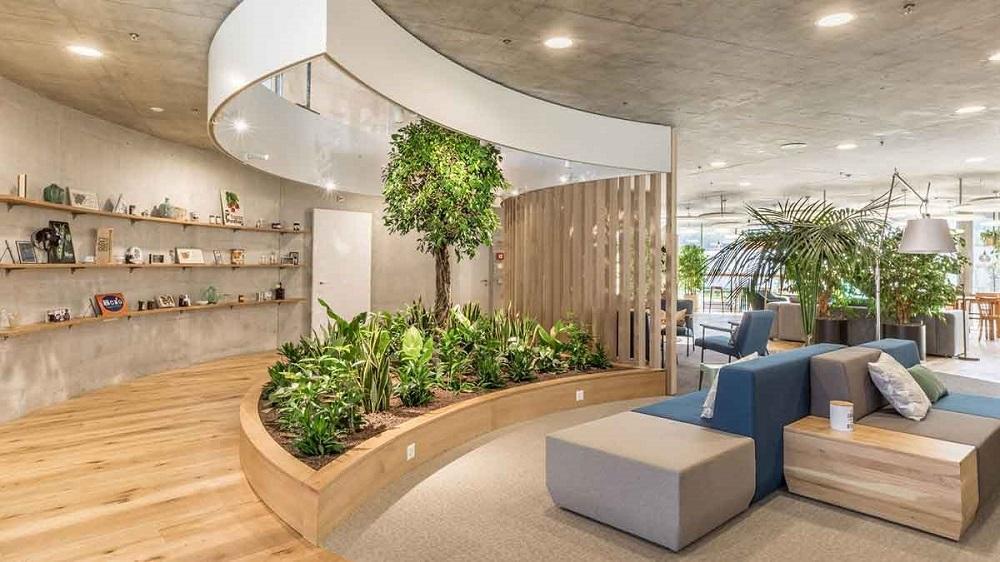In today’s fast-paced and technology-driven world, finding ways to reconnect with nature has become essential for our overall well-being. The concept of biophilic design offers a refreshing solution by seamlessly integrating elements of nature into our indoor spaces, creating harmonious environments that promote health, happiness, and productivity. In this guide, we’ll explore the principles and benefits of biophilic design and provide practical tips for incorporating it into your living and working spaces.

Understanding Biophilic Design:
Biophilic design is more than just adding a potted plant to your desk or a landscape painting on the wall. It’s a holistic approach to architecture and interior design that seeks to mimic nature’s patterns, forms, and processes within the built environment. This approach recognizes the innate human need to connect with nature and aims to foster that connection by creating indoor spaces that evoke the same sense of tranquility, wonder, and vitality found in the natural world. You can also hire an interior design company in UAE to design your home in a modern way.
The Benefits of Biophilic Design:
The benefits of incorporating biophilic design principles into your living or working space are numerous and well-documented:
Enhanced Well-being: Exposure to natural elements indoors has been shown to reduce stress, anxiety, and depression. Biophilic design promotes a sense of calmness and improves overall mental well-being.
Increased Productivity: Studies have demonstrated that incorporating nature-inspired elements in workplaces can lead to higher levels of productivity, creativity, and innovation among employees.
Improved Air Quality: Many natural elements, such as plants, contribute to better indoor air quality by filtering out pollutants and releasing oxygen.
Strengthened Connection to Nature: Biophilic design helps bridge the gap between the urban environment and the natural world, allowing occupants to experience the benefits of nature even when indoors.
Energy Efficiency: Certain biophilic design strategies, such as maximizing natural light and ventilation, can reduce the need for artificial lighting and HVAC systems, leading to energy savings.
Incorporating Biophilic Design:
Bringing biophilic design into your space doesn’t require a complete overhaul. You can start by integrating a few simple yet impactful elements:
Natural Light: Maximize the use of natural light by arranging furniture to allow sunlight to penetrate deeper into the space. Avoid heavy curtains or blinds that block out sunlight.
Indoor Plants: Introduce a variety of indoor plants, such as succulents, ferns, and air-purifying plants, to bring a touch of greenery into your space. Hanging planters and vertical gardens are also great options for small spaces.
Nature-Inspired Materials: Incorporate natural materials like wood, stone, and water features. Wooden furniture, stone accents, and indoor waterfalls can help create a more organic and calming atmosphere.
Biomorphic Patterns: Use fabrics, wallpapers, and artwork featuring natural patterns like leaves, flowers, or ocean waves to evoke a sense of connection to the outdoors.
Views of Nature: If possible, position furniture to take advantage of scenic views outside. Whether it’s a garden, park, or water body, a beautiful view can have a positive impact on your well-being.
Dynamic Spaces: Create dynamic and diverse spaces that cater to different activities. A cozy reading nook with natural light, a serene meditation corner with indoor plants, or an open workspace with a green backdrop can all contribute to a biophilic environment.
Water Features: The soothing sound of flowing water can enhance the calming effect of your space. Consider adding a small indoor fountain or aquarium.
Artwork and Sculptures: Incorporate nature-inspired artwork and sculptures that evoke feelings of being outdoors. Landscapes, wildlife, and abstract representations of natural forms can all work well.
Designing with Intention:
When incorporating biophilic design, it’s important to approach it with intention and thoughtfulness. Consider the following tips to ensure a successful integration:
Cohesiveness: Maintain a cohesive design by selecting elements that align with your overall aesthetic. Biophilic design should enhance, not disrupt, the existing style of your space.
Balance: Strike a balance between natural elements and modern comforts. Ensure that the space remains functional and conducive to your daily activities.
Maintenance: Be mindful of the maintenance requirements of your chosen biophilic elements. Select plants and materials that are well-suited for indoor environments and align with your ability to care for them.
Personal Connection: Infuse your personal connection to nature into the design. Whether it’s a cherished nature-inspired artwork or a collection of seashells, these personal touches can enhance the authenticity of the space.
Flexibility: Design your space to be adaptable. As seasons change or your needs evolve, having versatile elements like movable planters or adjustable lighting can help you maintain a biophilic connection.
In Conclusion:
Bringing nature indoors through biophilic design offers a transformative way to enhance our living and working environments. By incorporating elements of nature into our spaces, we can tap into the restorative power of the natural world, promoting well-being, productivity, and a deep sense of connection. Whether you’re redesigning your home, office, or any indoor space, embracing biophilic design principles can lead to a more harmonious and fulfilling lifestyle. CK Architecture is a perfect interior design company in Dubai to redesign your home and office in a modern design. So go ahead, let the beauty of nature inspire your design journey and create a sanctuary of tranquility and vitality within your own walls.





